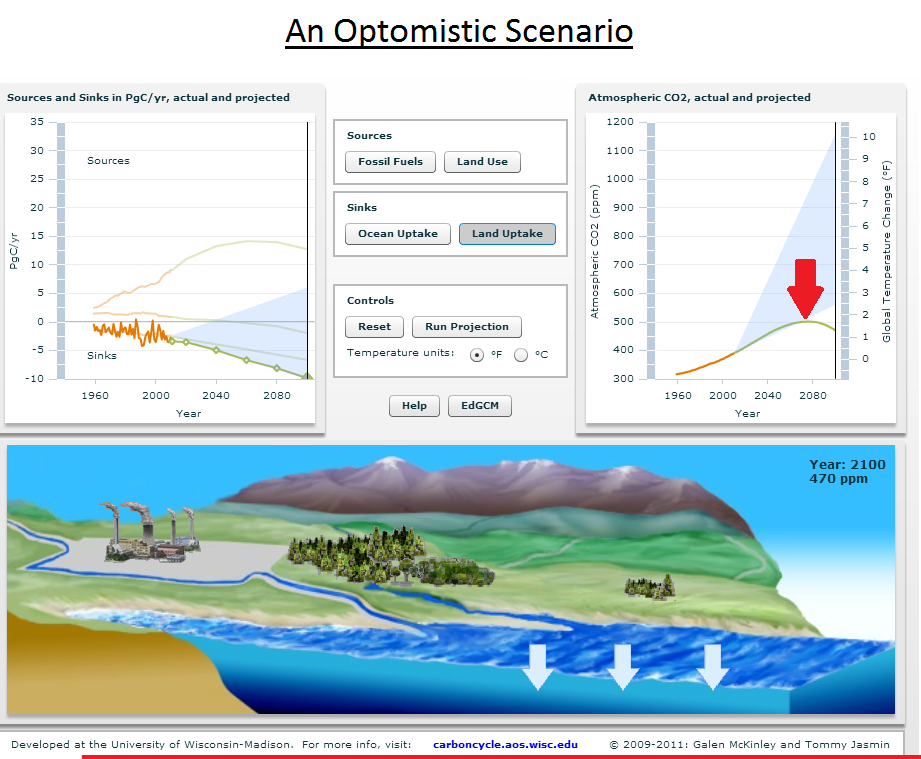The Precedence of Carbon
June 26, 2013
BY Kolby Hoagland
Today, President Obama outlined his plan to mitigate climate change by limiting the emissions of carbon dioxide from the combustion of fossil fuels to the atmosphere. The plan that President Obama and others in charge (primarily in Europe) have laid out aims to reduce the ever climbing concentration of atmospheric carbon. Academia and researchers are very confident in their understanding of the influence of carbon dioxide and other GHGs emitted into the atmosphere, despite the dispute from pundits in media.
One academic, Dr. Galen McKinley at the University of Wisconsin- Madison developed a website to help those of us without atmospheric science degrees but a strong interest in how humans affect the carbon cycle to understand how our actions directly affect climate change. The website enables perusers to tweak the foundations of carbon’s life on earth, carbon sinks and carbon sources.
The Applet portion of McKinley’s website allows users to run different scenarios on how humanity affects the sequestration of carbon on earth into sinks and the emission from sources into the atmosphere. McKinley’s website runs variable scenarios that the user controls and provides an estimated atmospheric carbon dioxide concentration (ppm)in the atmosphere and the presumed average global temperature change according to the provided scenario. After running multiple carbon uptake and emissions scenarios on McKinley’s website, it was striking to grasp the great potential of mitigating climate change by reducing the use of fossil fuels and implamenting agriculture that increases “land uptake” of carbon.
Advertisement
The photo below is a screenshot of an optimistic scenario where we assumed that bioenergy increasingly replaces fossil energy and our land is managed to sequester more carbon. In the scenario, the concentration of carbon dioxide in the atmosphere peeks at roughly 500 ppm in 2065. The purpose of the Applet on McKinley’s website is not meant to run scenarios that will exactly predict the futre, but rather to help us understand the magnitude of changing the current momentum of our changing climate and the importance of why we must do something to decelerate that momentum.

Advertisement
Related Stories
The U.S. Department of Energy Bioenergy Technologies Office (BETO) announced up to $23 million in funding to support research and development (R&D) of domestic chemicals and fuels from biomass and waste resources.
The U.S. DOE has announced its intent to issue funding to support high-impact research and development (R&D) projects in two priority areas: sustainable propane and renewable chemicals and algal system cultivation and preprocessing.
Sens. Sherrod Brown, D-Ohio, and Pete Ricketts, R-Neb., in August introduced the Renewable Chemicals Act, a bill that aims to create a tax credit to support the production of biobased chemicals.
The Chemical Catalysis for Bioenergy Consortium, a consortium of the U.S. DOE’s Bioenergy Technologies Office, has launched an effort that aims to gather community input on the development of new biomass processing facilities.
USDA on March 8 celebrated the second annual National Biobased Products Day, a celebration to raise public awareness of biobased products, their benefits and their contributions to the U.S. economy and rural communities.
Upcoming Events










